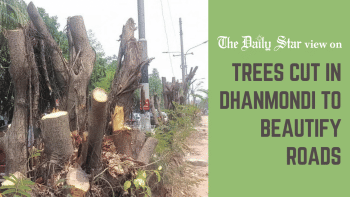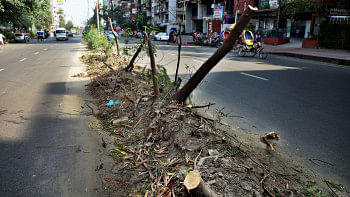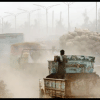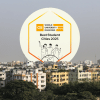Why I feel suffocated by Dhanmondi

Dhanmondi, let's face it, has long ceased to be the tranquil haven surrounded by trees, lake, and playgrounds. Long gone are the quaint two-storey houses with trees in the yard. Children no longer ride their bicycles or play cricket or badminton on the streets during the weekend. The chirping of birds is replaced by honks, blares, and loud profanities of frustrated drivers as soon as day breaks, and major playgrounds are at the mercy of ruling party elites, commoners be damned.
Dhanmondi these days is a cacophony of people, traffic, events, vendors, schools, hospitals, restaurants, and construction sites. For most residents, it is a challenge to simply get out of the area. During school hours, as I try to strategically manoeuvre the minefield that is Dhanmondi traffic, without losing my sanity (or my job, to which I risk being categorically late), I often bemoan the tragic fate of the directive issued by the High Court over a decade ago to remove all commercial establishments from the area.
Responding to a writ petition from a citizens' group in Dhanmondi, the High Court in June 2012 declared that operations of commercial institutions were illegal in the residential area, except for the establishments on Road 2, Road 27, and Satmasjid Road. Predictably, there was pushback from the schools – Maple Leaf International School filed an appeal against the order. What's surprising, however, was that the Dhaka South City Corporation (DSCC) also filed a petition stating that it was not obliged to implement the High Court verdict. (It's anybody's guess why the foremost city authority for Dhaka South would be so averse to bringing peace and tranquility back to a residential area). In August 2016, the Supreme Court upheld the High Court verdict against unauthorised commercial activities in Dhanmondi to protect its residential character and environment, and dismissed the DSCC petition.
A decade ago, when I had questioned the authorities about how they planned on implementing the directive, they had engaged in what the city authorities inevitably seek refuge in every time we ask them why they are failing to do their job: try to pass off the responsibility to others. The DSCC pointed to the Rajdhani Unnayan Kartripakkha (Rajuk), Rajuk pointed to the Public Works Department (PWD), and the PWD seemed flabbergasted that someone had the audacity to expect them to know what to do. The answers have remained much the same over the decade – a reluctance to accept responsibility – and on our end, too, the questions have dried up. Citizens' groups, who actively sought to implement the directive by mobilising on their own at the beginning, eventually gave up and/or decided it wasn't worth displeasing the powers-that-be who, after being in power for over a decade, have become less and less receptive to public opinion.
In a country that has no shortage of progressive laws, policies, and court directives, but no willingness to implement them, it is perhaps no surprise that the Supreme Court directive now exists only on paper, as if to tease Dhanmondi dwellers of what could have been.
As someone who loved growing up in Dhanmondi, I now feel increasingly suffocated by it. The playgrounds which we frequented when we were younger are no longer accessible, unless you know someone who is a Big (BCL) Brother or are associated with the clubs who now lease them. The Dhanmondi Road 8 field has been occupied for over a decade by the Sheikh Jamal Dhanmondi Club for training and practices. The protracted fight by environmentalists and residents to stop the occupation back in 2008-09 could not save the beloved playground from its eventual demise as a public space, nor did the 2011 High Court order that the playground be freed for use by the children and other residents in the area, or the show-cause notice issued by the court again in 2013.
The largest playground in Dhanmondi, known as Abahani playground, was leased out to Abahani Limited Dhaka on a long-term basis by the PWD. After being fenced off for construction and beautification for a long period of time, a small part of the playground was reopened to the public. Excited by the prospect of introducing my two-year-old toddler to the field in which her uncle grew up playing football, I took her for a visit on a weekend. But it was so dusty – from the unfinished construction work – that we had to leave almost immediately. Meanwhile, the Kalabagan Krira Chakra occupies the Kalabagan field, while the field at Dhanmondi Road 4 is occupied by the Dhanmondi Cricket Academy.

As residents, we deserve to know why these public grounds were leased out or allowed to be occupied for the use of a few people, depriving thousands of people of much-needed breathing and recreational space. The community was clearly never consulted before such decisions were taken, and the residents' protests over the years have been largely ignored or strategically silenced.
The Dhanmondi Lake, our pride and joy, has turned into a hub of commercial activities too, leased out to six different businesses, whose owners are mostly affiliated with the ruling party. According to architect Iqbal Habib, who helped design the Dhanmondi Lake Park, only three percent of the lake was supposed to be dedicated to cafeterias and restaurants, but thanks to the DSCC, commercial activities now take up 12-15 percent of the area. It is little wonder that there are plastic cups, plates, straws, and garbage littering the now green water of the lake and surrounding pathways, with the lessees least concerned about ensuring management, clean-up, and security of their designated sectors, as per the conditions of the lease. Given the identity of the lessees, it is hardly a surprise that the DSCC, which earns a whopping Tk 2.93 crore each year from the leases, doesn't monitor or hold them accountable for such gross violations of the terms.
In a residential area where people's concerns and needs have long taken a backseat, it is perhaps only fitting that a ludicrous project like the one on Satmasjid Road would be undertaken. To begin with, the new median has blocked off all the turns on the busy road which used to allow and ease the constant flow of traffic from the inroads of Dhanmondi. This has led to more traffic building up inside the residential part of the area, as well as making it considerably more inconvenient for people living in West Dhanmondi and Rayerbazar to commute. Simply crossing the road – which takes two minutes on foot – can now easily turn into a 30-minute misadventure if you're in a car or rickshaw.

It is inconceivable that more than 500 trees – many of which were planted more than 15 years ago – have been mercilessly felled to make way for this ill-thought-out scheme that we are supposed to embrace as "development." One can easily imagine the motives behind breaking the existing median and building a new one – given that it is part of a Tk 1,719 crore integrated project (cha-ching!) – but the authorities are yet to provide a logical explanation as to why the new median could not be built while keeping the trees in place. Once again, the DSCC did not bother to seek public or expert opinion, nor did they seek permission from the forest department before carrying out the massacre. And even in the face of protracted protests from environmentalists and residents, under the banner "Save the trees of Satmasjid Road" – some of whom have been guarding the trees at night for the past months – to stop the onslaught on the trees, the DSCC mayor has not even felt it necessary to meet with them and at least hear out their concerns and demands.
It is evident that we, as residents of Dhaka, have no say over the quality of our lives in this concrete jungle that we lovingly or grudgingly call home. And most of us seem to have accepted this fate, if the turnout at the protests at Satmasjid Road are any indication. It's time we organised to demand the kind of city that we need and deserve, because clearly no one else is looking out for us.
Sushmita S Preetha is op-ed editor at The Daily Star.

 For all latest news, follow The Daily Star's Google News channel.
For all latest news, follow The Daily Star's Google News channel. 











Comments